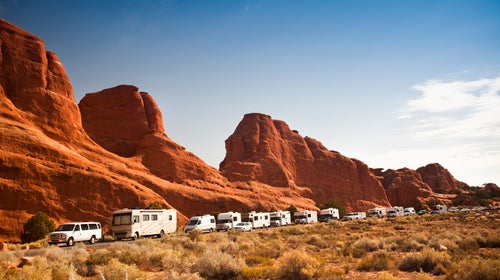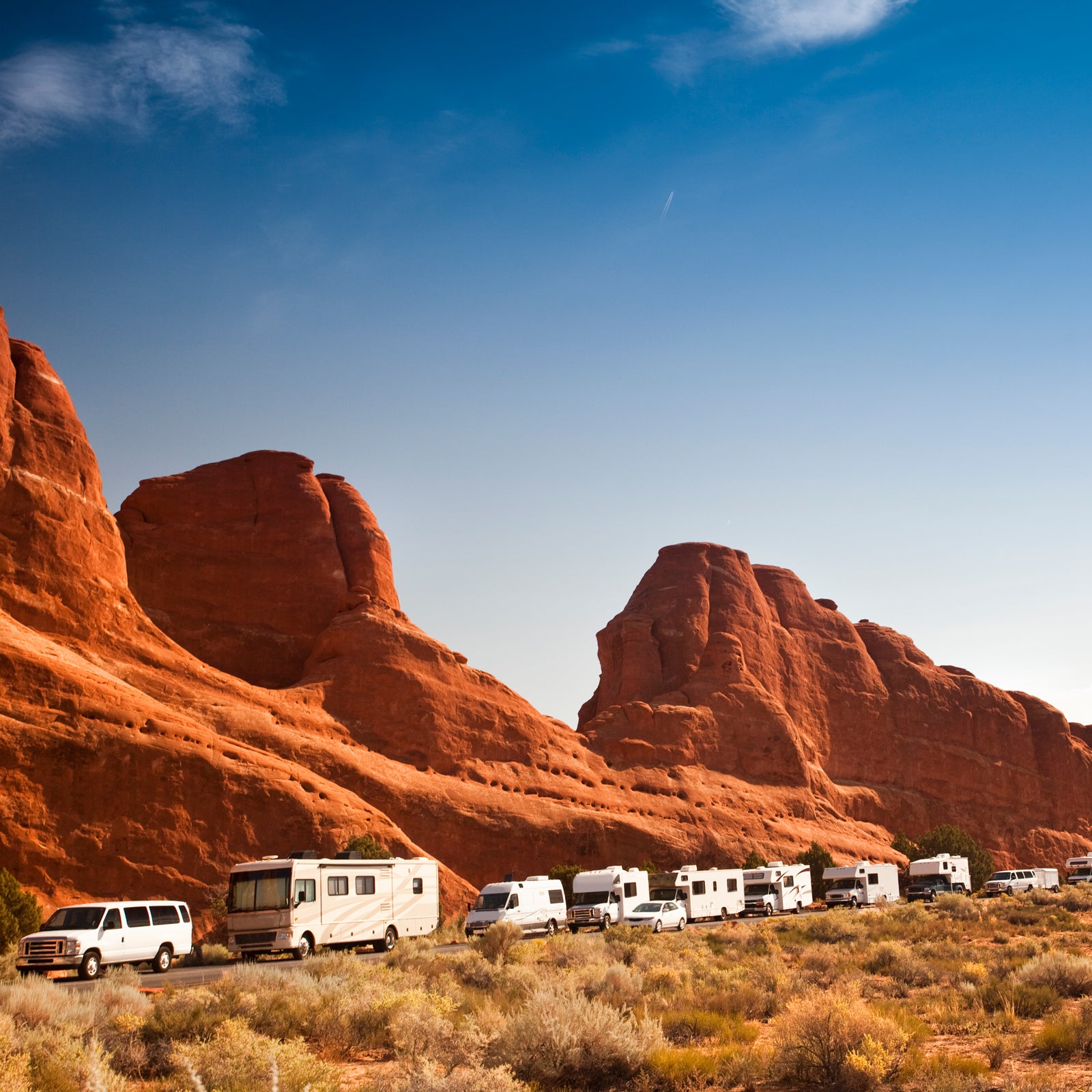A controversial advisory panel╠řfor the Interior Department has to privatize national-park campgrounds, allow commercialized services such as Wi-Fi and food trucks, and limit benefits for seniors. Critics fear that the plan will create financial barriers to entry by upping fees and╠řerode the visitor experience by increasing crowding and noise pollution. Unsurprisingly, it represents yet another step toward public-lands privatization╠ř▓╣▓ď╗ň an attempt to enrich the current administrationÔÇÖs cronies.
The planÔÇÖs recommendations were contained in a memo published last month by the╠ř, a group that was created by former interior secretary Ryan Zinke in 2017 and consists╠řof executives from the RV and hospitality industries, proponents of park privatization, and companies with direct business ties to the National Park Service.
ÔÇťPrivatizing AmericaÔÇÖs public campgrounds and jacking up national-park fees to appease big-business concessionaires and powerful corporate campaign donors is just the latest egregious attempt to rip public lands out of public hands,ÔÇŁ says Jayson OÔÇÖNeill, deputy director of the watchdog group .╠ř
The memo states up front╠řthat campgrounds are ÔÇťexcellent candidates for partner management under concessions and leases.ÔÇŁ From there it offers a series of recommendations aimed at turning over campground operations to private companies while bringing in additional concessionaires╠řfor ÔÇťmodernization, enhancement, or even new construction.ÔÇŁ╠řIt also proposes indexing campground prices to reflect inflation and the market (i.e., higher-priced private campgrounds outside park boundaries). Under the committeeÔÇÖs suggestions, the Park Service would also implement blackout periods for discounted senior-citizen camping fees during peak seasons. Concessions companies would also be offered free housing within the parks.╠ř
The memo also calls for ÔÇťcategorical permissionsÔÇŁ to sidestep environmental impact reviews for campground expansion and development.╠řThat lines up with the Trump╠řadministrationÔÇÖs , which compels federal agencies to consider the environmental impact of projects, says Mike Finley, a retired Park Service employee who served as╠řsuperintendent of Yellowstone National Park from 1994 to 2001 and of Yosemite and the Everglades before that.
The committee calls for these recommendations to be implemented through a╠řpilot program in five to ten╠řlocations, which could then be expanded to other parks and agencies within the Department of the Interior that oversee public lands, like the Bureau of Land Management.╠ř
The proposals are meant to remedy a campground system that╠řthe committee╠řcalls the ÔÇťvictimÔÇŁ of a $12 billion maintenance backlog, charging that it ÔÇťfails to meet expectations of the contemporary camping marketÔÇŁ and is ÔÇťan underperforming asset.ÔÇŁ
My╠řquestions are: What exactly are the expectations of the contemporary camping market, and should the National Park Service╠řbe required to meet them? (Probably not.) Should we consider our national parks a performing asset? (Never.) And is the Park Service actually being victimized by the $12 billion maintenance backlog? (No.)
The advisory panel believes that contemporary campers apparently expect Wi-Fi, electrical utilities, and food trucks, as the memo details. While the proposal doesnÔÇÖt explicitly call for more pavement, ÔÇťMade in AmericaÔÇŁ committee member Matt Miller, president of the RV manufacturer Newmar Corporation, has made it clear that the Park Service is letting his customers down. ÔÇťI donÔÇÖt even go to the national campgrounds with the units that we build,ÔÇŁ . ÔÇťYou canÔÇÖt fit in them, the sites are small and dirty, thereÔÇÖs grass growing in the campsite╠řÔÇŽ itÔÇÖs not the way it should be.ÔÇŁ╠ř
Grass in a national-park campground? I hope MillerÔÇÖs customers donÔÇÖt despair of the elk that come to eat that grass, hemming the tourists into their vehicles with a shake of their pointed antlers. But apparently thatÔÇÖs where the contemporary camping market prefers to stayÔÇösprawled shouting-distance apart in╠řbus-size╠řRVs, relaxing to the hum of their air-conditioners with their iPads on their laps.╠ř
ItÔÇÖs obvious, says Finley, ÔÇťthat these ideas have nothing to do with the quality of the visitor experience and everything to do with serving industry interest.ÔÇŁ
Accommodating larger RVs invariably means more pavement, a larger physical footprint, and more noise from generators, says Finley. ÔÇťEvery additional piece of infrastructure means less animal habitat, more disturbance, and fewer pristine views,ÔÇŁ he says. Expanding or adding additional campgrounds means more people in parks, which╠řalready have RVs and cars idling for an hour outside entrance stations. In 2018, national-park visitation , just down from a record 330 million the year before.
National parks arenÔÇÖt meant to be a performing asset, says Finley, but rather preserve and protect spectacular places and provide unique visitor experiences.╠řItÔÇÖs obvious, says Finley, ÔÇťthat these ideas have nothing to do with the quality of the visitor experience and everything to do with serving industry interest.ÔÇŁ
More amenities like Wi-Fi╠ř▓╣▓ď╗ň electricity will inevitably mean price increases, he says, as is foreshadowed by the memoÔÇÖs proposal to index prices to the campground market outside national parks. The last time the Trump administration proposed hefty national-park fee increases, it╠řfaced intense backlash:╠řits╠ř2018 plan to double entrance fees at the 17 most popular parks was assailed by critics who argued that raising prices would unduly affect children and underprivileged populations who benefit from visiting national parks.╠ř
The committeeÔÇÖs recommendations can be implemented by interior secretary David Bernhardt in much the same way the in national parks was enactedÔÇöhanded down through former acting National Park Service director Daniel Smith last month. Though there are potential legal challenges to orders issued by acting directors who havenÔÇÖt been confirmed by the Senate (which is also the case with current acting director David Vela), the best chance to halt such initiatives is probably with public outcry, the way the price hikes at national parks were blunted, says OÔÇÖNeill.
OÔÇÖNeill says the memoÔÇÖs mention of the $12 billion National Park Service maintenance backlog is another╠řTrump-administration tactic to justify the privatization or commodification of public lands. The argument goes that, facing such expenditures, which private companies can allegedly do more efficiently.╠ř
Watchdog groups, however, dispute whether the maintenance backlog is truly an issue. Nicole Gentile, who directs the public-lands program at the Center for American Progress, reported in 2017 that more than half of the $12 billion tab is for road maintenance, which typically comes from a separate budget from the parks-maintenance bill. She also found that only $1.3 billion is considered priority maintenance, and that another $389 million╠řwas earmarked for facilities where concessionaires run for-profit hotels, gift shops and, yes, campgrounds.╠řÔÇťThe backlog should be understood in context,ÔÇŁ says Gentile. ÔÇťIt shouldnÔÇÖt be used as a Trojan horse to increase privatization in parks. Concessionaires, not taxpayers, should be paying for upkeep on commercial facilities inside parks, and the federal government should appropriately fund the Park Service.ÔÇŁ And while Bernhardt decries the alleged $12 billion backlog, Gentile points out, he praised the proposed Trump-administration budget╠řthat╠řwould have cut nearly $500 million from the Park Service.╠ř
╠řrevealed that Interior Department staffers initially flagged several members of the╠řÔÇťMade in AmericaÔÇŁ Outdoor Recreation Advisory Committee for conflict of interest, including two whose companies have direct contracts with the National Park Service. Bruce Fears is president of Aramark, which holds a $2 billion contract to run hotels, eateries, and campgrounds in national parks. Jim Jacobs is co-CEO of Delaware North, a concessionaire best known for extorting the Park Service for . The Jacobs family has also to TrumpÔÇÖs various campaigns and political committees.╠ř╠ř
Committee member Linda Craghead serves as KansasÔÇÖs assistant secretary for parks and tourism and, notes the Post, touts:╠řÔÇťkey business strategies to transition the state park system from dependence on state funding to a self-sufficient business model.ÔÇŁ Notably absent on the committee are any of the applicants from the human-power-oriented Outdoor Industry Association╠řor any personnel from the agencies that actually administer the lands in questionÔÇöthe Park Service, the BLM, or the U.S. Fish and Wildlife Service.
Calls for park privatization and industrialization arenÔÇÖt new, notes former superintendent Finley.╠řÔÇťI fought the industrial-tourism bastards for years,ÔÇŁ he says.╠ř
In light of the committeeÔÇÖs proposals to reshape our public lands, the words of Edward Abbey, who famously polemicized the practice in Desert Solitaire, remain prescient: ÔÇťIndustrial Tourism is a threat to the national parks. But the chief victims of the system are the motorized tourists. They are being robbed and robbing themselves. So long as they are unwilling to crawl out of their cars they will not discover the treasures of the national parks and will never escape the stress and turmoil of the urban-suburban complexes which they had hoped, presumably, to leave behind for a while.ÔÇŁ


